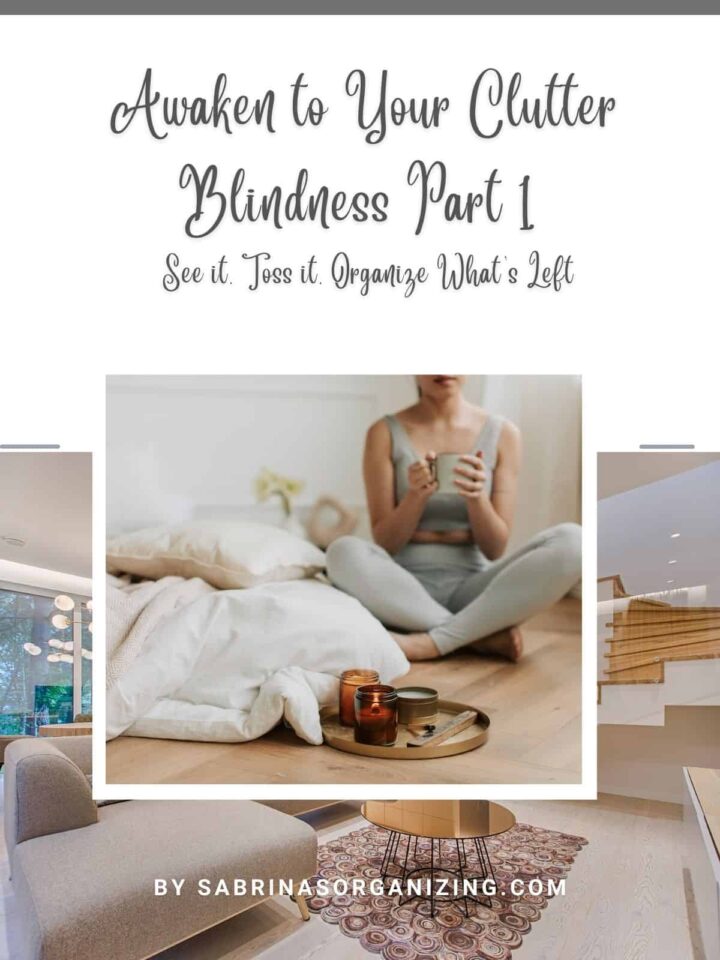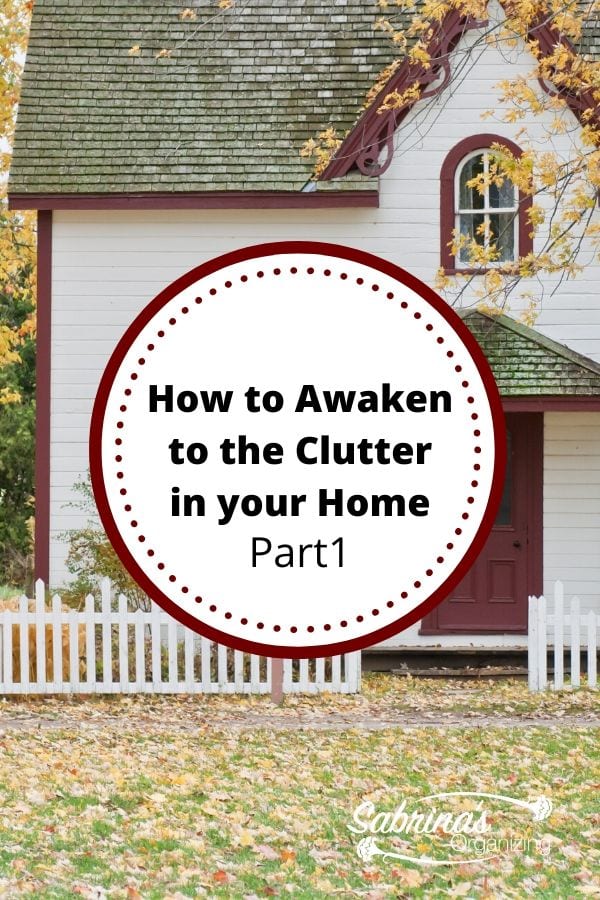****Visit our "Disclosure Policy and Cookies" for details. Affiliate links appear on this page from Google Adsense, Amazon, Order Out of Chaos, Impact affiliate members, Release, Repurpose, Reorganize, and Shareasale affiliate members.****
Are you wondering where the clutter is in your home? Have you ever walked around your home and couldn't find clutter you didn't want or need? Did you ever walk around your house and not see the clutter? You could be walking over things and not realize it. This is clutter blindness. Indeed, it is a massive obstacle before you start the decluttering process.
I will help you awaken to clutter blindness in your home seamlessly. So, in this three-part series, I will share how to awaken to clutter blindness and keep the clutter at bay once and for all.
Jump to:

Clutter blindness definition
Clutter blindness is defined as unseen clutter, even though it may be right in front of you. Your brain doesn’t process these items as clutter because it has become a fixture of your home or office, and you forget what these items were used for in the first place. The result of clutter blindness is cluttered homes and stressful lives.
11 Signs you have clutter blindness.
There are numerous signs that you have clutter blindness. Below are just some of them.
- You have many incomplete tasks around your home.
- Feeling unhappy with your home or life.
- The items become hazardous in your home. There are areas of paths to get through the room.
- Friends and family offering to help you clean could indicate that they see that clutter you do not see.
- Looking for things becomes an issue.
- You may have piles of things all around your home collecting dust, which doesn't bother you.
- There are no assigned places for things.
- No systems in place for papers.
- Spouses or family members are annoyed that the house is a mess.
- You feel like the house is never cleaned.
- You always say 'yes' to free stuff.
If you can relate to these signs, you probably are clutter blind. Now, what to do about it? This three-part series will show you how to awaken to the clutter blindness that occurs. Read on, and get the free book and worksheet to awaken the clutter in your home.
Awaken to the Clutter in your home - Part 1
Since this clutter blindness process doesn't happen overnight, I have derived a way to reconnect to the clutter in a home and office.
Here are the first steps on how to awaken to the clutter in your home:
First, pick a room and start with a notepad marked with 5 columns and write the following header at the top of each column:
- Assign a Task Name - be specific and make sure it isn't several tasks. The way to keep tasks manageable is to break them down into small steps. It may seem like many steps, but you can handle them easily because it is more realistic.
- Tasks take 15-30 minutes - check if this column can be completed now. This task would take less than 15 minutes or ½ hour to do.
- Tasks take 1-2 hours- check this column to see if it can be completed in two hours.
- Tasks take 4-6 hours - Check this column if a particular task has several steps and involves planning.
- When should I have it done? - Add the date that you want to finish it by. Nothing else. Remember, this is only to help you awaken to the clutter.
Next, write down how you are feeling during this process.
Ask yourself these questions while finding the clutter in the room to help you determine how you are feeling.
- What room should I work in first and why?
- What is the most important task in this room?
- How do I feel while looking at these unfinished tasks?
- Are there tasks I listed here not going to help me reach my room/life goals?
- Will I be able to do these tasks myself, or will I need help? If I need help, who will I ask?
Now create a roadmap.
Now it is time to create a roadmap for the room. Write down the list of tasks you have to do for this room. This part is where you will break down the list of tasks above to be even more specific.
To organize the tasks, you can write down specific tasks on sticky notes (Affiliate Link) and organize them from the first step to the last step. I included a Roadmap and Even More Tasks pages in the free Awaken to Your Clutter Blindness ebook.
Free Shipping and Free 60 Days Returns
If you want a free instruction ebook and workbook I made for you and all my other ebooks, please add your information here, and I will send you the one I made.
Learn more about how to determine your definition of clutter.
Where should I start to find this clutter?
Start at the entryway of any room in your house that you wish to awaken to the clutter.
Close your eyes, take a deep breath, and let it out. Open your eyes and walk into the first room.
Then, slowly start from the right of the doorway and look around the room. Look for signs of incomplete projects like:
- Items that are out of place
- Items that need to be taken care of
- Trash that may need to be thrown away
- Items that need to be given away
- Projects that need to be started
- Projects that need to be completed
Write down the uncompleted projects and items that need to be removed and corrected on your notepad, and assign 'a deadline’ for every task.
Remember to pretend you are in someone else's house to help minimize the judgment you may have about the clutter you see.
Schedule the time to complete these tasks.
With your checklist (Affiliate Link), detailed tasks, and your planner, assign a time for each task. This may take some time to do, so don't be discouraged.
***AD*** from Released Repurpose Reorganize: My List Simplified journal is a wonderful organizing tool for planning a move or a renovation. Use it to corral all the to-dos.
Another note: I recommend only doing one room at a time. First, complete all the tasks in one room. Then move on to the next room. If you create too many to-do lists (Affiliate Link), you will feel overwhelmed and not want to do any tasks. The goal here is to awaken from clutter blindness and NOT judge yourself for incomplete tasks.
How do you feel after doing this process? Did it help you look at the room differently? Did it help you determine what tasks you should do first? Please leave a comment below on how this experience affected you. I would love to hear from you.
The next step is the purging process. Visit these posts for the rest of this awakening to clutter blindness series:
How to Take Care of Clutter in the Home - Part 2 of this series
How to Sort Kept Items – Part 3 of this series
A quick note before you go.
Are you ready to define the clutter and simplify your life? This clutter-blindness process is the best stepping stone to our Virtual Organizing service! Reach out, and let's talk about action-oriented tasks to do weekly while you lighten your life.
Please note these are affiliate links through Amazon, and at no additional cost, I will earn affiliate fees if you decide to make a purchase.
I found this article to help further you clear the clutter in your home: How to Get Rid of Clutter in Your Home












Julie Bestry says
Clutter blindness is closely tied to what I call "tolerations," aspects of our spaces where we just tolerate a problem for so long that we cease to notice or care. It can be a water stain from a room leak, a light bulb that's out for far too long, or — as you note — clutter that we just stop noticing it. Judith Kolberg's old trick of using an empty paper towel roll like a telescope to force you to look at one small area of your space is a trick to try if you're still in belief after those 11 possible signs. Great stuff!
Sabrina Quairoli says
Great suggestion, Julie! Thanks for joining the conversation.
Hazel Thornton says
My first clients on my first day as a professional organizer introduced me to clutter blindness. Two sisters sharing an apartment and I went through all their rooms and discussed what could be done to declutter and organize their spaces. Finally, we were standing next to a sideboard in the kitchen/dining area. They were acting like we were finished with the tour. I said, "But, what about this clutter?" They said in unison, "What clutter?" I gestured toward the cluttered sideboard. They looked at each other and burst out laughing! They agreed it was cluttered and that neither of them had noticed it before. I was flabbergasted and grateful that they had a sense of humor about it!
Janet Barclay says
I had an experience similar to this many years ago. I had removed the baseboards to paint my kitchen, decided the baseboards needed to be replaced so I got rid of them, but didn't get around to replacing them until the house was put up for sale. I realized that I walked through that room so often that I didn't see that there were no baseboards. I can easily see the same thing happening with clutter.
Jonda S Beattie says
One way I help clients see the clutter in their space is to have them take pictures of the area and share them with me. They often say that they did not realize how much stuff had built up until they looked at the pictures.
Sabrina Quairoli says
Thank you for the suggestion, Jonda. It's great!
Linda Samuels says
One of the issues with clutter blindness is the obvious of NOT being able to see the clutter. So even entering a room to evaluate what needs to be taken care of might be challenging.
There is a strategy that can often help. Take a photo of the room or area in question. Seeing a space from a different view, a removed view (like in a picture), can help you notice things you might not have seen previously.
From there, you can make a plan.
Sabrina Quairoli says
Great suggestion! Thanks for commenting, Linda.
Diane Quintana says
It is so easy to become blind to the clutter in our homes. Stuff gets put down or a project halted for a short time. Before you know it, it's sat there unattended for longer than you realize. I like the way you have outlined a method to open your eyes and truly see what is in your home one room at a time.
Hazel Thornton says
It is so true that we just don't see the clutter after awhile. My very first home assessment as an organizer was for two sister roommates. We addressed their areas of concern, then (as we stood in the dining area) I said, "What about the rest of the clutter?" They both said, simultaneously, "What clutter?!" I pointed at the cluttered surface of the sideboard. They both looked and we all started laughing. Lesson learned, for all of us!
Sarah Soboleski says
I love the step by step nature of this post. It's really a great game plan for tackling clutter and it's very engaging. And I love the reminder about taking deep breaths.
Andi Willis says
Seeing what is truly around you is such a great first step. Some many people live in the clutter without seeing it after a while. Thanks for the terrific step-by-step.
Hilda Rodgers says
Very important point you made about not judging yourself! It's so hard not to feel bad when looking around at everything that's accumulated around you. But if we hold on to those judgmental feelings we'll be less likely to deal with the clutter.
Jill Robson says
Great suggestions on how to start organizing. Sometimes just taking the time to really look at a space is a great reminder of how you want the room to look.
Seana Turner says
Naming the clutter is a good idea - it is a way to tame the "beastly" projects! What a nice option for people trying to do this on their own:)
Janet Barclay says
I love the way you organize the task list according to how long each one will take. That's a great strategy that should be applied to all to do lists!